
Kyoto, Japan
Known as Ippon or Ihiho to the people who live here, Japan, situated in East Asia, in the midst of the eastern Pacific Ocean, is a world-famous island. The word “Japan” means rising sun in the Kanji dialect. Thus, the other name of Japan is “Land of the Rising Sun”.

According to me the most beautiful city of Japan is Kyoto. Being the capital of Japan, it has played a special role in the History of Japan’s development. The city has a past full of violence and bloodshed, it has been affected by bombshells and bullets over and over again. However, it was stricken off from a list of targets for the atom bomb in 1945. It was felt that destroying a city with such a rich heritage would be a sin. Kyoto is famous for its marvelous Buddhist temples, Shines, and other monuments. Despite its dark past, the beautiful city of Kyoto thrives on.

Kyoto is located in the Yamashiro district. The city is surrounded by the lofty mountains of Higashimaya, Kityama, and Nishiyama on three sides and a river on the other side. Kyoto is famous for its efforts to protect its natural and historical sites. It takes great care of its 2000 places of religious interest. 1,600 of these are Buddhist temples and 400 of these are Shrines which are unique to Japan. But it’s not just religious temples and shrines that contribute to the city’s cultural heritage. The city is also adorned by majestic palaces, beautiful gardens, and monuments. In fact, 17 of the 22 UNESCO World Heritage Sites of Japan are located in Kyoto.
My affair with this country and Kyoto in particular, began in the month of February 2018 when I had to come here for official work. Since Kyoto does not have its own airport, we alighted at Kansai airport in Osaka and traveled to Kyoto by road. We booked into a guest house known as the Shugakuin International House. This was to be my home for a year. Though the Shugakuin International House has all the amenities of a guest house, it is exclusively meant for foreigners associated with the Kyoto University. One has to be really lucky to get a room in this guest house. Firstly, the rooms are allocated through a lottery system. Secondly, thousands of people from all over the world come for courses and research at Kyoto University and try to get a room here. The guest house is situated in the city of Shugakuin, just 3.7 kms away from the university. Shugakuin is an incredibly well-planned city. You’ll find all you need here, convenience stores, shops, schools, parks and markets at a stone’s throw distance . In Shugakuin one discovers a truly multicultural place bustling with people from all over the world.

People here use cars and cycles more than other forms of transportation. After all, they do not have the options of using “autos” and “rickshaws” like we do in India. What they have are the trains and busses. The Buses have a fixed fare, whether you take the bus to the next stop or alight at the last stop, you have to pay 230 yens. However, when you take a train, the fare depends on the distance you travel. Even the minimum train fare is pretty good at 210 yens. As such, people naturally prefer using cycles for short distances. In Japan, we bought three cycles, one of them with a baby seat attached. Yes, you read that right! In Japan, it’s illegal to let your kids sit on the carrier. You must have a baby seat on your cycle. If your kids are not in their baby seats or don’t have a helmet, you will be fined. In fact, cycles are given so much importance in Japan, you actually have to get your cycle registered and insured! When in Japan, you see different kinds of cycles, you get normal cycles as well as cycles which operate on electricity, you see shopping malls completely dedicated to selling different brands of cycles. Their prices range starts from 25000 Yen . I have even seen cycles that are priced around 2.5 lakhs Yen! Be it a 4-year-old or an Eighty-year-old, everyone here owns a cycle and rides it with absolute ease!
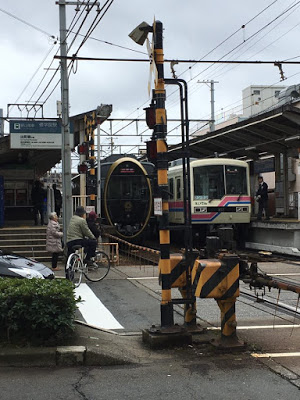

Kyoto is quieter than most cities in Japan, the heavenly peace that prevails over this city makes it seem like a city worthy of being an abode to gods. The more I explored other famous cities in Japan like Tokyo, Osaka and Nara the more I realized how strong my bond with Kyoto had grown. The city of Kyoto is so clean you could pretty much sit down anywhere on the streets. With an eagerness to help, and a smile that touches their eyes, the simplicity, warmth, and hospitality of the people of Kyoto make it even more special. In the last 7 months I stayed here, these people never once made me feel like an outsider. I still remember all the smiling faces that greeted me and my daughter, as I cycled her back home from her school. I used to be so taken aback by the unexpected greetings of “Konichiwa” (good day) from these unfamiliar faces, I never bowed my head at them or wish them back. Now, I have become one of them, I always meet their greetings with a bow, this short exchange never ceases to leave me with a sense of happiness. Another word every newcomer in Japan must learn is “Arigatou gozaimasu”, Arigatou meaning thank you. In Japan, you hear the word everywhere, in schools, in shops, on streets, everywhere. It is almost as if the saying thank you fills them with a kind of joy that cannot be found elsewhere.


This city never ceases to surprise me. Not only do we discover new places every week, but we also come across new customs, new ways of living. Though these customs seem strange to me, to the people of Japan they are part of everyday life. For example, the public toilets in Japan are so clean and well maintained, we would have a hard time believing that they are indeed meant for ordinary people. You won’t be able to spot any litter on these streets, the people of Japan take a special interest in keeping their streets clean. If someone does find any litter lying around, the person will immediately pick it up and go throw it in a dustbin. I have never seen the people break traffic signals, not even when the streets are empty. I have never seen the people in Japan push each other on crowded buses or heard them raise their voices at each other. I have never seen anyone here smoke at a public place or use his or her phone on the bus or the metro. The buses here have two separate doors, one meant for entry the other for exit. It is only when one person exists that another can board the bus. Even when the bus of the train is crowded people wait in disciplined queues instead of getting impatient. Queues can even be spotted on the escalator!
The Shugakuin railway station is right next to Shugakuin International House. Most trains which come herein this station has two to three compartments. They look a lot like the toy trains we are all familiar with. However, if you go to the train stations in bigger cities, you will find bullet trains as well as express trains.


While in Japan we often saw trees growing on roadsides, the seasonal flowers created a canopy over the roads, inviting cyclers to go explore a little further. In February and March, Kyoto is transformed by the Sakura or the Cherry Blossom Season. During these months foreigners as well as Japanese tourists flock to the city of Kyoto to see the breathtakingly beautiful cherry blossoms. Watching the cool wind carry the falling pink and red flowers is truly a sight to behold. The Kyoto Botanical Garden organizes light shows to celebrate the colors and the splendor of the cherry blossom season.

Every street in Kyoto has its own temple or shrine. Though the shrines and temples may look different, they serve a similar religious purpose. Shrines are the religious places of the Shinto community. The Shintos have their own set of believes and way of worship. The Shrines can be identified by their Torri gates. The temples in Japan are the religious places of the Buddhists.

In the past 7 months, we covered 12 of the 17 world heritage sites here. We visited one site every week. If someone comes to Japan for 15-20 days and spends 3-4 days in Kyoto, he or she simply must visit these 15 places.
1. Kiyomizudera ( 清水寺, “Pure Water Temple ): Located on the top of a mountain, this beautiful isolated temple is made entirely out of wood. This temple is famous for its hanging wooden platform situated 13 meters above sea level. Tourists mostly visit this temple in spring when the cherry and maple trees in their bloom and the temple looks its best. The temple is also famous for its beautiful bird’s eye view of the city.This is one of the 17 World Heritage of Kyoto.


2. Nijo Castle, 二条城, Nijōjō: The Nijo castle, recognized as a UNESCO world heritage site, has played an extremely important part in Japan’s history. In fact, this is the biggest castle in the Kyoto under protection. The castle has two parts, the Ninomaru Palace and the ruins of the Honmaru Garden.
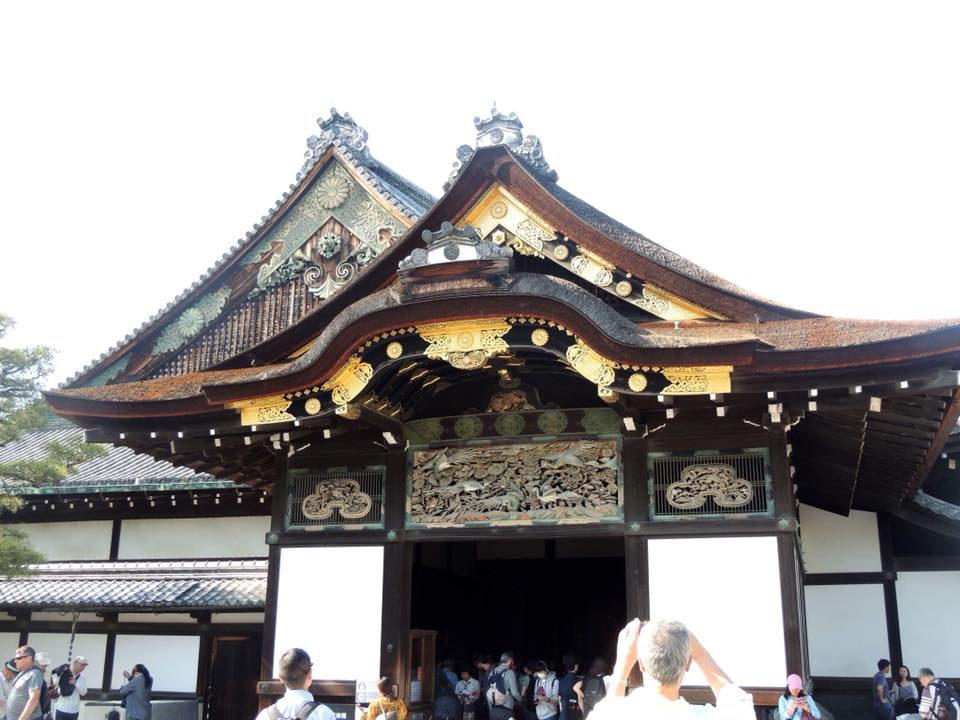
Today, the Ninomaru Palace is the main attraction of this castle. The ceiling embellished with intricate patterns, beautiful paintings on sliding doors, the bamboo tatami mats, draw attracts people from all over the world. Walking through this hall created a kind of echo throughout the palace, this was meant to warn people of trespassers.
3. Kinkaku-ji (金 閣 寺, Golden Pavilion): located to the North of Kyoto, the Kinkaku-ji is a Zen Buddhist temple. The top two floors of these temples are completely covered with pure gold leaves. The Kinkaku-ji too is a World Heritage Site. The reflection of the Golden Pavilion in the lake outside is a truly picturesque site, it attracts many tourists and photographers. Another model of this is the Ginkakunji (銀 閣 寺, Silver Pavilion).

4. Fushimi Inari Taisha (伏見稲荷大社): This is the most important Shinto Shrine in South Kyoto. It is famous for having thousands of Tori gates which lead to Mt Inari. Each gate is dedicated to someone and donated by someone. Even the smallest gate is valued at 8 lakh yens and it is said that the biggest one is around a Million Yen.

5. Toji Temple (東寺, Tōji): This world heritage site is famous for its 5 storied pagodas, the only such pagoda in Kyoto. Along with this, it is also famous for its garden and the fairytale-like ambiance.

6. Kyoto Tower: At 131 meters tall, this tower is located right next to the Kyoto Station. The tower has a viewing deck for those who want a glimpse of the unbelievably beautiful fairytale town of Kyoto.
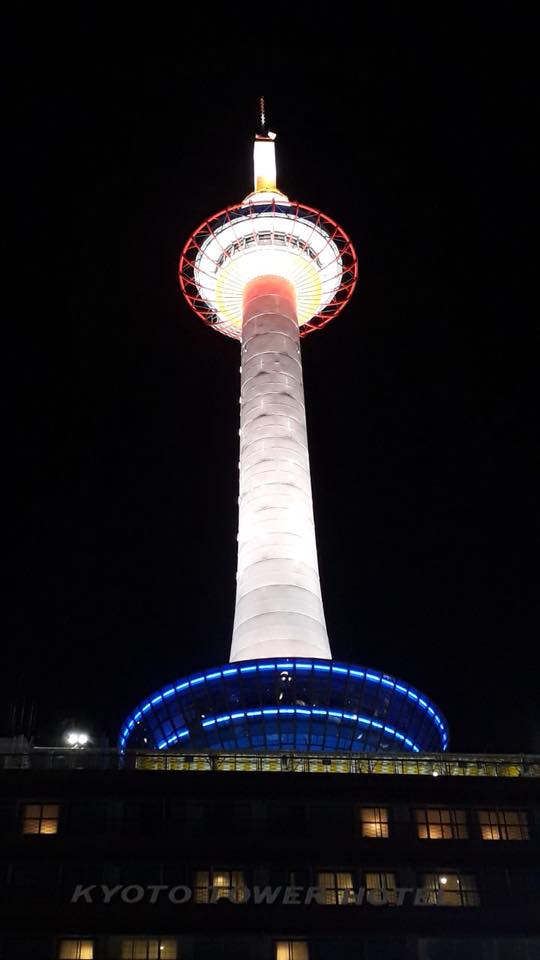

7. Arashiyama (嵐山): To the west of Kyoto is the district of Arashiyama. This district is well known for its many tourist attractions, the Togetsukyo Bridge, the Bamboo Groves and its two world heritage sites the Tenryuji Temple and the Daikakuji Temple.

8. Ryoanji (龍 安 寺): This is one of Japan’s most famous Zen gardens, visited by hundreds of tourists every day. The garden is surrounded by a wall, the rock garden is made up of 15 stones arranged in small groups. The garden is famous for its design which ensures that only 14 out of the 15 rocks can be seen at once, no matter where you view them from, one rock is always hidden from view.

9. Yasaka Shrine (八坂神社, Yasaka Jinja): Located in the Gion district of Kyoto, this shrine is also known as the Gion Shrine. This shrine is famous for holding the Gion Matsuri. The Gion Masturi along with Aoi Matsuri and Mitarashi Masturi are some of Kyoto’s most well-known festivals. The word Matsuri is used to refer to a major festival in Kyoto. I consider myself lucky for being able to experience these festivals here.

10. Nishiki Market (錦市場): Nishiki is a local food market near Sanjo and Shijo Kawaramachi. Here you can expect to find all the ingredients for preparing any kind of traditional Japanese food. Be it Sushi, Japanese Pickles, Dried sea fish or sweets, you’ll find it all here! In fact, this market is often called the Kyoto’s Kitchen.

11. Enryakuji (延 暦 寺) Temple and Mount Hiei (比叡 山): Situated in the Eizan mountain range, the Enryakuji temple is one of the most important monasteries in Japan’s history. It may be called the birthplace of the Tendai sect of Japanese Buddhism. A large number of Japan’s most revered monks still study in this monastery today. Their strict education system and pious religious practices are highly respected in the Buddhist world.

12. Shugakuin Emporium Villa: The Shugakuin Palace is just 2 km away from the Shugakuin International House. The garden here is one of the grandest gardens you will find in Japan.

13. Biwa Lake: This is Japan’s biggest freshwater lake. This lake is so huge that it is impossible for someone standing on its bank to make out whether it is a lake or a sea. The clear blue waters of the lake which fade into the horizon draw both international tourists and Japanese people to this spot. Along one side of this lake, you will find the Omimako Beach. It is on this beach that you will find a cruise ship for tourists. The cruise lasts around one and a half hours. It takes you to some of the freshwater islands in this lake. The floating Tori gate here is another mention worthy tourist attraction. In August, one hour long light shows are held here, tourists from far off countries visit the Biwa Lake to see these light-shows every year.


14. The Heian Shrine: This Shinto monastery, which was built in 1895, celebrates the Imperial family and commemorates the first and last emperors to live in Kyoto. This gigantic Tori Gate, extensive field and monthly fairs seem to invite tourists back to this place over and over again.
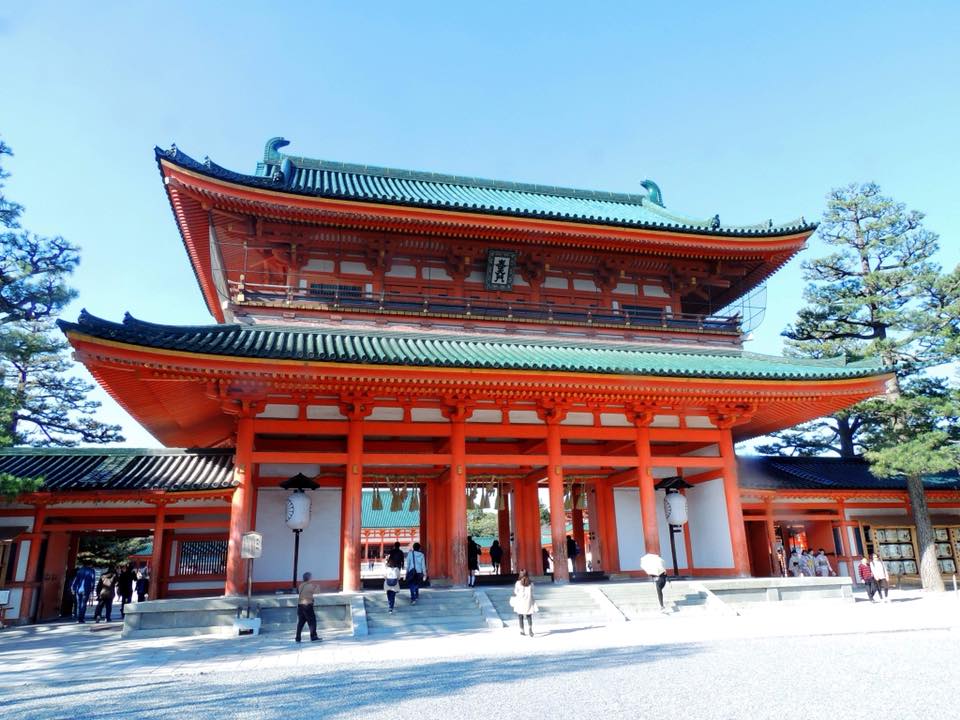
15. Kyoto Aquarium: This is one of my favorite places in Kyoto to go with my family. This Aquarium has all the aquatic creature you could think of. Here you can watch dolphin dance and penguins play about. You even stand a chance of encountering the needle-thin snakes you’ve read about in the stories of Lakhinder. In fact, it is hard to think of an aquatic creature you can’t find here. All you have to do is take a bus from Kyoto station and you’ll reach this aquatic wonder world in 10mins.


Apart from these world heritage sites there are the Shimogamo Shrine (下鴨神社, Shimogamo-jinja), Kamigamo Temple, Nanzen-ji Temple, Eikan-dō Zenrin-ji Temple , Kyoto Imperial Villa, Kimono Forest ,the sparkling clean Sanjo Shiro Dori, the Kyoto station area, the Big Camera shop, the green fields around Shugakuin and the ever-flowing Kamo River never fail to impress me.
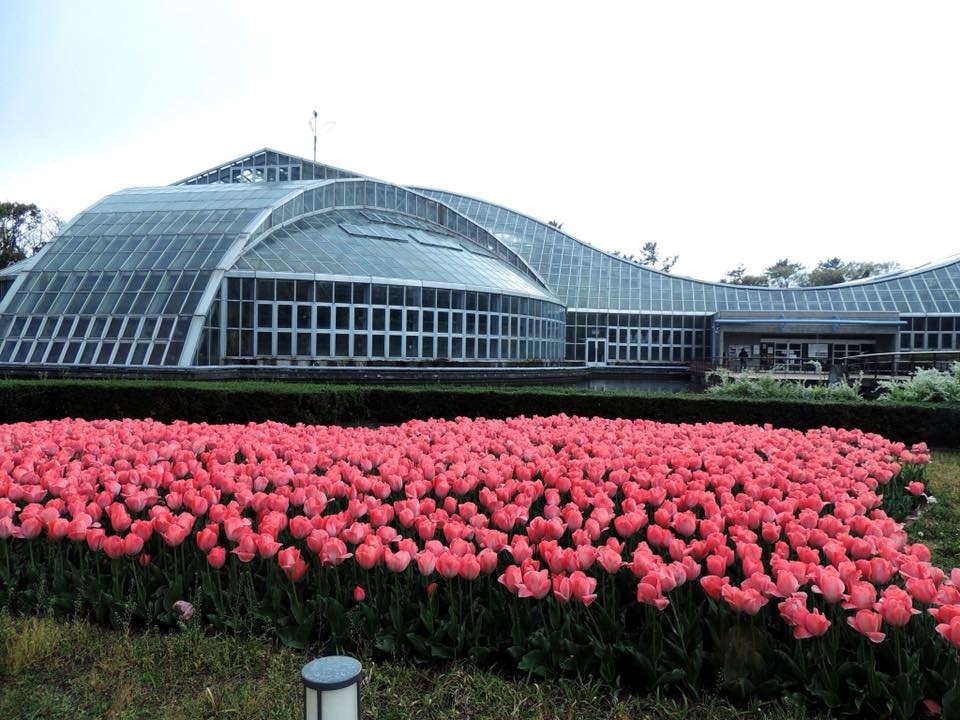

I’ve been to so many new places since I moved here, I’ve been part of so many of their festivities I had never heard of before. However, at the end of the day, Kyoto reminds me of my country. They too have calendars full of festivities. There’s something going on every day. Like us, Japan too has its own religious beliefs and its own superstitions. Their temples too are illuminated by candles and filled with incense. People queue up to ring the bell, to pray for good luck and to buy lucky charms at the shops outside.


Like us, they too have fairs during their summer holidays. I see my childhood joys reflected in the happy faces of these Japanese children. Miles away from my hometown, years later, in a different age, I seemed to have found something that connects me to my childhood, a common thread that runs through cultures uniting India and Japan.

One thing to note about Kyoto is that most people here do not understand English. However, as long as you have mobile internet and your G.P.S. you will have absolutely no problem finding your way through the streets of Japan. For me, my G.P.S. was the one travel companion I just would not leave my room without.
It is in Japan that I recorded an earthquake for the first time in my life. On 21st June 2018, Kyoto was hit by an earthquake just as it was 21 years ago. The earthquake left me sleepless for 10-15 days. I felt everything was shaking. There were around 45 aftershocks. Then came the flood alerts. Though the floods did not affect Kyoto, Hiroshima suffered heavily. For the past few days, there have been Typhoon alerts going around. And finally on 3rd September,2018, TYPHOON JEBI, the strongest storm in last 25 years, caused major destruction in all over Japan .If a country like Japan could be imperfect in any way, I would have to say Japan’s imperfection lies in its vulnerability to natural disasters.
Japan is a country that cannot be described in words. My descriptions of Kyoto and the people in Japan can but give you a glimpse of life in Japan. In Japan, I learn something new every day. For example, less than 15% of Kyoto’s population understands English, yet the city continues functioning efficiently. We have much to learn from this country, how to improve our productivity, how to improve our education system, how to inculcate the right values in the younger generation and above all, how to love our country.

Different people have different ideas about Japan. Like most people, I had always dreamt of going to Europe or America too. It must have been my fate that brought me to Kyoto in Japan. However, I am thankful that I ended up here. I feel my life would have been rather incomplete if I had not experienced all that I did here. You’ll find it hard to believe that a city like Kyoto could exist that is until you see the city for yourself. It is close to impossible to see all there is to know about a country or for that matter a culture. It is even harder to put all that you experience into words. Anything I could say or write would fall short of the praise and respect this country deserves. No number of words could do justice to the richness of experience Japan has provided for me. My life in Japan has been full of excitement, awe, and surprise and I am certain that as long as I am here, Japan will not allow a moment of dullness in my life.

— Mousumi Kundu Paul
Kyoto,Japan| An Experience | Copyright @ M K Paul; September,2018


